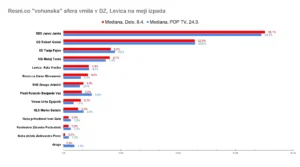By: Peter Jančič (Spletni časopis)
The extensive coverage by major media outlets of Resni.ca, which was even featured on Erika Žnidaršič’s show Tarča last week, where they did not invite SLS, despite having MEP Franc Bogovič, has lifted this party above the threshold for entry into parliament, as shown by a survey conducted by Mediana for Delo, practically catching up with the Levica of Asta Vrečko, which holds very similar “peaceful” views on the war in Ukraine.
This was revealed in a survey published today by Mediana for Delo. In the previous elections, the Levica’s prominent candidate, Violeta Tomić, gained fame in Europe with the stance that Crimea, once occupied, should not be returned to Ukraine. If the result shown by the Mediana survey were achieved in the European elections, it would be a severe setback, as both Resni.ca and Levica would remain well below the threshold, which is much higher in European elections than in parliamentary ones.
In the media, Resni.ca has received a lot of attention in the past week because the former chief of police, advisor to Danilo Türk, and Resni.ca candidate in the EU elections, Bojan Potočnik, bid a very warm farewell to Russian intelligence officer Sergei Lemešev when the country showed him the door due to intelligence activities against our state, allegedly even paying politicians and journalists who spread Russian propaganda here. With this affair, which is particularly embarrassing for the state security services, the Russians could potentially infiltrate them through Potočnik, the media provided additional promotion to Resni.ca before the EU elections in a segment of the population that believes in Russian propaganda and would otherwise vote for the Levica or one of the other two government parties.

On the more right-leaning side, propaganda for Vladimir Putin is spread by the Slovenian National Party (SNS) led by Zmago Jelinčič (who was a fundamental part of left-wing governance after independence), where the former chief of Resni.ca, Zoran Stevanović, was once a member. SNS has also gained ground and is just below the threshold for entry into the National Assembly.
Among all parties, the Slovenian Democratic Party (SDS) led by Janez Janša remains by far the most popular. Attempts by journalistic propagandists in major media outlets, under the control of government parties, to portray Janša as Slovenia’s Viktor Orbán or even Putin ahead of every election, have not resonated. According to Mediana’s measurement for Delo, the current government coalition parties would easily lose power in the elections, and even if they allied with Resni.ca, they would remain in opposition. Janša would then form the government.
Long-term trends show that power relations are relatively constant. Additionally, the Social Democrats (SD) have failed to return to a position where they could threaten the dominance of the Svoboda party on the left, which they lost when Svoboda party and Robert Golob managed to shift blame for the bizarre government purchase of a decaying building in Ljubljana, which judges rejected, and funded it with money from state reserves, onto the SD and lower officials.
The percentages of support for parties in the graphics and the article are calculated based only on voters who have made a party preference. This allows for comparison between elections and between surveys. Among those who have expressed a preference for a party, I also include the choice of “other” parties. These are those parties that are not offered to respondents (for example, the five parliamentary parties) but are remembered by respondents themselves. The original percentages of support for various parties from different surveys, as published by the media and used as the basis for calculations, are presented in the table (by clicking, you can enlarge all tables).
Providing all the data that formed the basis for calculations facilitates understanding the differences between measurements and also allows for verification to see if there were any errors in the transmission and processing of data.